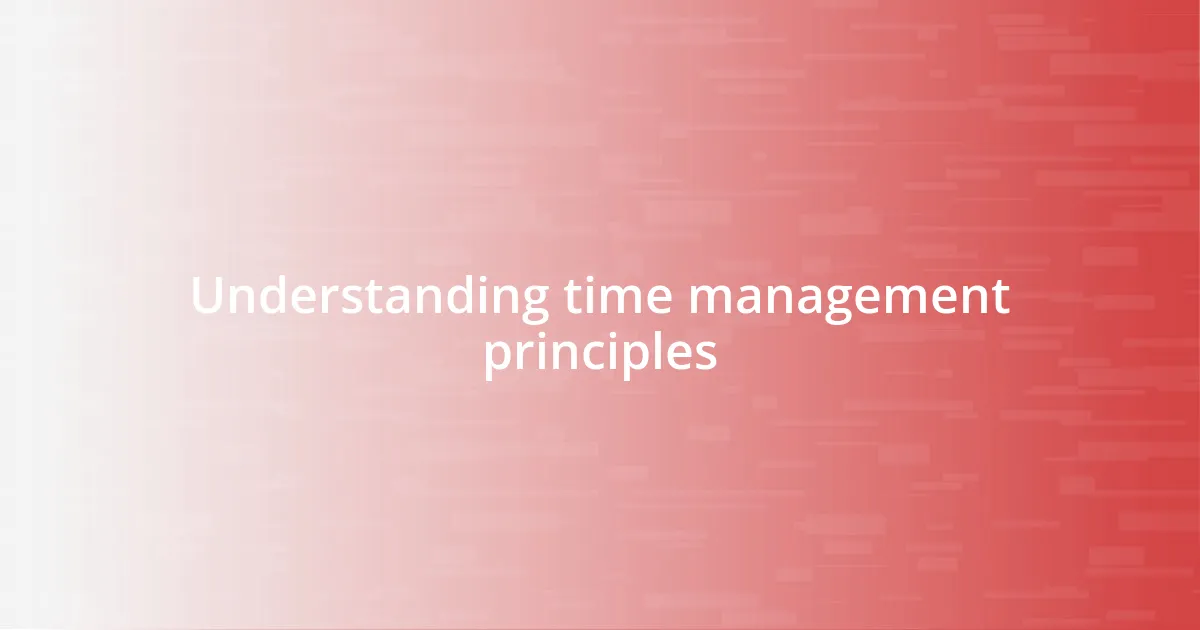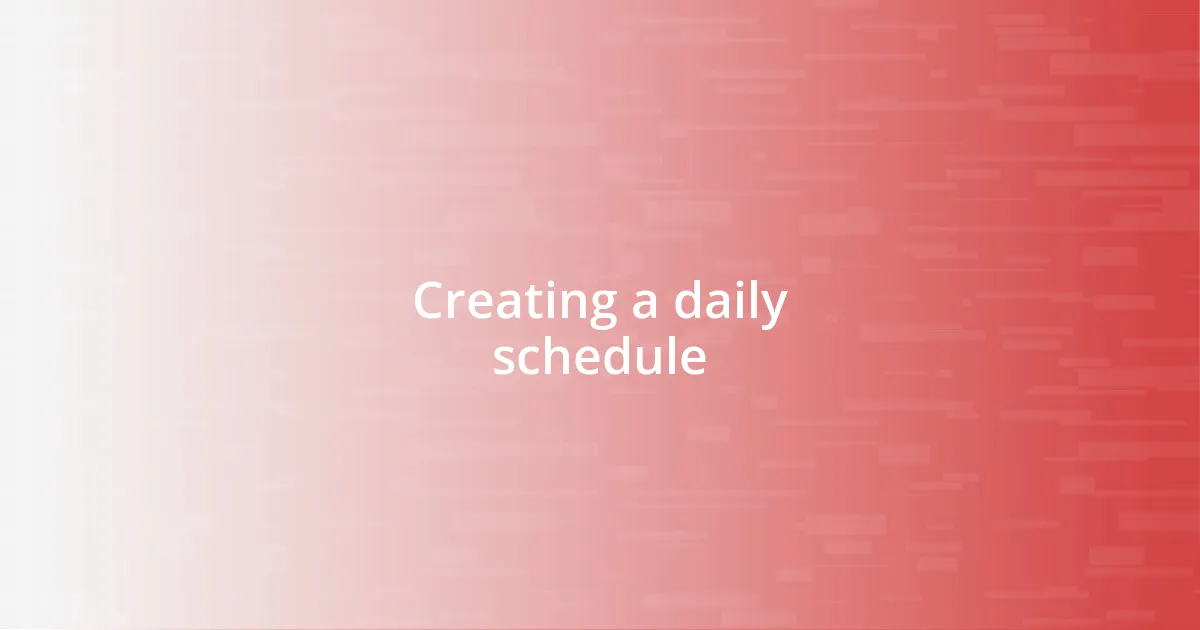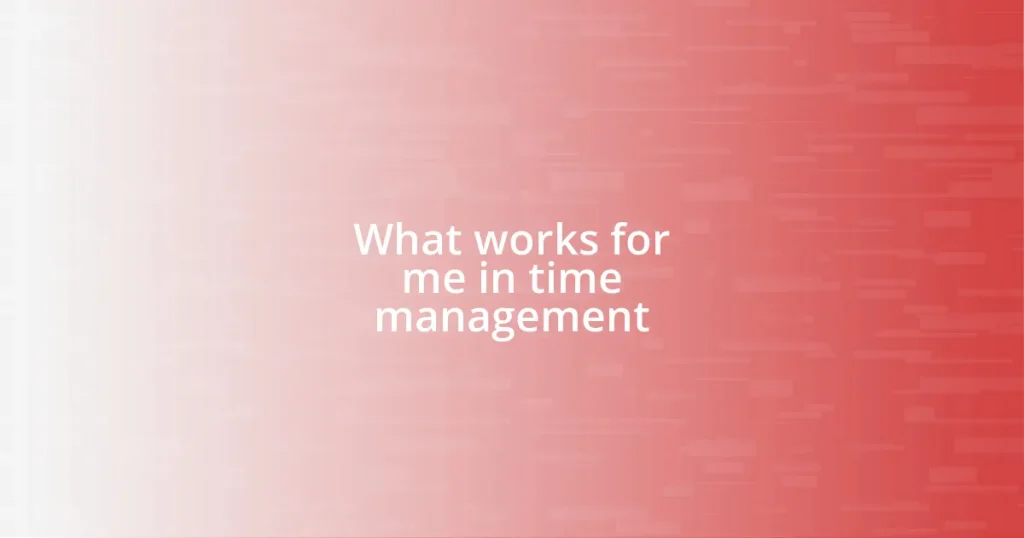Key takeaways:
- Understanding time management principles involves aligning actions with personal values and recognizing the Pareto Principle (80/20 rule) to focus on high-impact tasks.
- Setting clear, categorized goals and reviewing them regularly reduces mental clutter and enhances productivity.
- Creating a daily schedule with flexible buffers promotes structure while allowing for unexpected changes, boosting accountability and control over time.
- Establishing a dedicated workspace and digital boundaries, along with learning to say “no,” helps minimize distractions and prioritize essential tasks.

Understanding time management principles
Time management isn’t just about schedules and to-do lists; it requires a deeper understanding of our priorities. I once found myself overwhelmed, trying to juggle numerous tasks without recognizing what truly mattered. It dawned on me that aligning my actions with my values fundamentally shifted how I approached my time.
One principle that resonates with me is the idea of the Pareto Principle, or the 80/20 rule. In my experience, I’ve noticed that roughly 80% of my results come from just 20% of my efforts. This realization transformed my focus—I started identifying which tasks yielded the most significant impact. Have you ever tried to pinpoint your own vital few tasks? It can be a game-changer.
Another key principle is the importance of setting limits. When I first began setting boundaries around my work hours, I discovered more clarity in my personal time. Instead of letting work seep into every corner of my day, I learned to cherish my free time, which ultimately boosted my productivity. Isn’t it incredible how defining our limitations can actually lead to greater freedom?

Setting clear goals and priorities
When I started to set clear goals, it was like turning on a light in a dim room. I began marking out what I wanted to achieve, both in the short term and long term. This gave me a clearer path and ensured I was not just dashing from one task to another. I often make a list of my goals, categorizing them into personal and professional. This simple exercise helps me focus on what truly matters.
- Identify specific goals: What do I want to accomplish this week?
- Prioritize tasks: Which of these will have the greatest impact on my objectives?
- Set deadlines: When do I want to achieve these goals by?
- Review and adjust: How often will I revisit these goals to see if they need updating?
Taking the time to write down my priorities has significantly reduced the mental clutter I once felt. I remember a hectic week where I was overwhelmed by minor tasks. It struck me that they were drowning out my main priorities. So, I took a step back, simplified my focus, and just like that, everything felt more manageable. Setting those clear intentions allowed me to reclaim my time and energy, reinforcing the idea that clarity is essential for effective time management.

Creating a daily schedule
Creating a daily schedule has, quite frankly, been a game-changer for my productivity. I remember when I first attempted to chart out my day—I set aside a quiet morning, coffee in hand, and decided to block out time for each of my tasks. It felt almost liberating to watch my chaotic list transform into manageable chunks of time. What I’ve learned is that a daily schedule isn’t rigid; it’s a fluid plan that gives structure without stifling creativity.
At first, I was hesitant to stick to a schedule. There were days when unexpected tasks would crop up, throwing me off course. I’ve since realized that it’s essential to leave some wiggle room in my plan—allocating buffer time between tasks helps absorb those surprises. For instance, if I plan to write for an hour, I carve out an additional 15 minutes afterwards. This accounts for any distractions, but more importantly, it allows me to reflect on what I’ve accomplished. Doesn’t that sound refreshing?
Maintaining consistency is another aspect that has greatly influenced my approach to time management. I’ve found that revisiting my schedule weekly not only keeps me accountable but also sparks a sense of accomplishment as I cross off completed tasks. It’s akin to a mini-celebration each time I review my week. By making it a habit, I’ve noticed not just an increase in productivity but also a greater sense of control over my time. How about you? Have you established a routine that helps you manage your day more effectively?
| Time Management Strategy | Example |
|---|---|
| Task Blocking | Dedicated time for writing, meetings, or projects |
| Flexible Buffers | 15 minutes between tasks for unexpected delays |
| Weekly Review | Reflect on achievements and adjust next week’s schedule |

Utilizing time blocking techniques
Utilizing time blocking techniques has transformed the way I approach my day. I vividly remember one particularly overwhelming month, where my tasks felt like a vast ocean threatening to drown me. After learning about time blocking, I started breaking down my day into distinct segments—suddenly, those waves turned into a series of manageable puddles. Each block became a mini-session dedicated to specific tasks, and it was incredibly satisfying to check them off one by one.
Sometimes, the real challenge lies in sticking to those blocks. I’ve had days when my scheduled task unexpectedly took twice as long, and I would panic. But I’ve learned to embrace flexibility within my blocks—if something runs over time, I simply adjust the next session accordingly. It’s about being realistic with how I allocate my energy. Have you ever found yourself racing against the clock, only to realize later that you’re overcommitting? By giving myself grace and adjusting on the fly, I’ve turned that potential frustration into a valuable learning experience.
Moreover, I often like to visualize my day as a puzzle. Each block fits into a larger picture, and if one piece doesn’t fit perfectly, it doesn’t ruin the whole image. That has made me more compassionate toward my productivity goals. For example, after a week of successful time blocking, I noticed my evenings felt more peaceful—I wasn’t scrambling to finish tasks at the last minute. Instead, I found time to unwind and reflect on what I accomplished. Isn’t it freeing to picture your time as something you control rather than something that controls you?

Minimizing distractions and interruptions
To truly minimize distractions, I’ve had to reevaluate my physical workspace. For example, when I first transitioned to remote work, I struggled with household interruptions. I decided to create a dedicated office space, away from the commotion of daily life. This subtle change allowed me to foster a mindset focused solely on work. Have you ever noticed how a cluttered environment can weigh on your productivity? I certainly have, and decluttering my space was essential for keeping my focus sharp.
In addition to my physical environment, I’ve learned the importance of digital boundaries. When I first started working from home, I would fall down the rabbit hole of social media notifications. Realizing how much this interrupted my flow was a wake-up call. I began setting specific times for checking messages and social media, which has notably reduced those pesky interruptions. What about you? Have you tried minimizing digital distractions? The difference I felt in my productivity was immediate; suddenly, I was in control of my time rather than my devices dictating my focus.
Lastly, I’ve discovered the power of saying “no.” Initially, I struggled with this. I felt obligated to accommodate every request—whether it was attending meetings or helping with extra tasks. However, prioritizing my time means sometimes letting others down. I began evaluating requests based on my current schedule and goals. It’s liberating to assert my boundaries. Have you ever found it hard to say no? I’ve learned that protecting my time allows me to be more present and committed to the tasks that matter most.

Reflecting on and adjusting strategies
Reflecting on my time management strategies has become a crucial part of my routine. I often carve out a few minutes each week to analyze what’s working and what’s not. I remember one week when I felt constantly overwhelmed—despite following my plans, something just didn’t click. It was through honest reflection that I realized I had packed my schedule too tightly. Sometimes, stepping back allows clarity to surface. Have you ever found that a little self-reflection can reveal hidden obstacles?
Adjusting my strategies isn’t merely a matter of preference; it’s essential for my growth. I used to cling to certain methods even when they failed me. For instance, I spent weeks trying a new productivity app that seemed perfect. But as I reflected, I recognized it was causing more stress than it alleviated. I switched back to a simple notepad, and instantly felt the relief wash over me. How do you handle times when a strategy isn’t living up to your expectations?
Emotionally, I find that these adjustments can be liberating. The realization that it’s okay to pivot—whether it’s shifting my daily priorities or trying a completely different approach—has been transformative. I remember the first time I decided to cut down on after-work commitments; the relief was palpable. I created space for self-care and hobbies, and that sparked my creativity in unexpected ways. Have you experienced a similar shift? Ultimately, reflecting and adjusting isn’t just about productivity; it’s about aligning my time with what truly nourishes me.

Maintaining work-life balance
Maintaining a healthy work-life balance has been a journey for me, often filled with trial and error. I vividly recall a time when I was working late into the evenings, convinced that the extra hours would lead to greater productivity. Instead, I found myself increasingly exhausted and disconnected from family and friends. The realization hit me hard: by sacrificing my personal time, I was actually diminishing my overall effectiveness. Have you ever experienced that sense of burnout?
To address this, I started to schedule “me time” into my calendar, just like I would for a crucial meeting. Whether it’s a quiet evening with a book or a weekend hike, I now prioritize activities that recharge my batteries. This newfound approach has not only improved my mood but has made me more focused during working hours. Just the other day, I took a long walk instead of diving back into emails, and it sparked fresh ideas when I returned to my desk. How do you make time for yourself amidst the hustle?
I’ve also learned the importance of setting boundaries with work, particularly when it comes to technology. At one point, I noticed myself constantly checking work emails well into the night. To combat this, I established a firm cutoff time each evening. That small decision brought a sense of relief; it was like unshackling myself from a never-ending to-do list. Now, when I log off, I can fully engage in my personal life. Have you thought about how technology impacts your work-life balance? For me, those boundaries have been life-changing.















